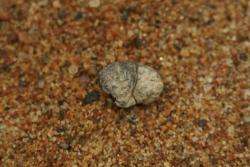Here's A Story To Get Your Teeth Into...

Discarded chewing gum is the bane of town centre pavements across the UK – but imagine finding a piece that’s a jaw-dropping 5,000 years old?
That’s just what University of Derby BA (Hons) Heritage and Conservation student Sarah Pickin found during an archaeological dig in Finland recently.
The 23-year-old, from Uttoxeter Old Road in Derby, was one of just five UK students on a unique volunteer programme at the Kierikki Centre on the west coast of Finland when she made the find – a piece of Neolithic chewing gum – a chewed cob made from birch bark tar.
Sarah also found part of an amber ring and a slate arrow head, all of which will be on display at the centre after they have been analysed in laboratories.
The Centre manages public excavations between May and October to unearth items of historical importance in an area of woodland called ‘Kierikkikangas’ which dates to the Neolithic period, c. 4,000-5,000 BC.
One of the Kierikki Centre’s supervisors, Sami Viljanmaa, said: “This gum substance of that period was often used as chewing gum and could also have been used to repair damaged arrowheads.
“This and the other two items that Sarah discovered were very exciting finds.”
Sarah’s tutor at Derby, Professor Trevor Brown, an expert in Heritage and Conservation, said: “Birch bark tar contains phenols, which are antiseptic compounds.
"It is generally believed that Neolithic People found that by chewing this stuff if they had gum infections it helped to treat the condition. “It’s particularly significant because well defined tooth imprints were found on the gum which Sarah discovered.”
Colleague Sini Annala said: “The actual material is some kind of tar, that was made by heating birch bark. After the tar was made, it was boiled, and when it cooled, it became solid.
“When it was heated again, it became softer, and it was used at least sometimes as some kind of chewing gum. Birch bark tar was also used as glue for repairing broken ceramic pots and to unite quartz or slate arrowheads to their shafts.”
Sarah said: “I was delighted to find the gum and was very excited to learn more about the history of the items. I am keen to work in this area in the future so the experience has stood me in good stead.”
The finds were made with help from two diggers from Oulu, Rumana Hossein and Maisoun Alsanat during Sarah’s trip, made possible through the Leonardo Di Vinci European Programme, and Grampus Heritage and Training Limited, based in Cumbria and help from the University’s Career Development Centre.
Sarah’s participation in the course, and her subsequent academic write-up will contribute 15 credits towards her degree, as she prepares to begin her final year of study.
In relation to the ring, its original diameter was four centimetres and the Centre says it was probably already broken in the Stone Age. After that someone made a hole in the ring so that it could still be used as jewellery.
This is the third piece of amber found at the Kierikkikangas site. Two pearls were found last year also with the help of British students.
The four centimetre long worked slate arrow is from the so-called “Typical Comb Ceramic period” 3,500-4,000 BC.
The first known mention of findings from ancient structures in the Kierikki area is from the 1800s*.
Finally, during excavations in the early 1990s, significant findings were made of foundations for dwellings and various objects.
*It became understood that the Kierikki area has been an important settlement for nearly 2,000 years, roughly between 5,000 and 3,000 BC, over 7,000 years ago.
Source: University of Derby





















